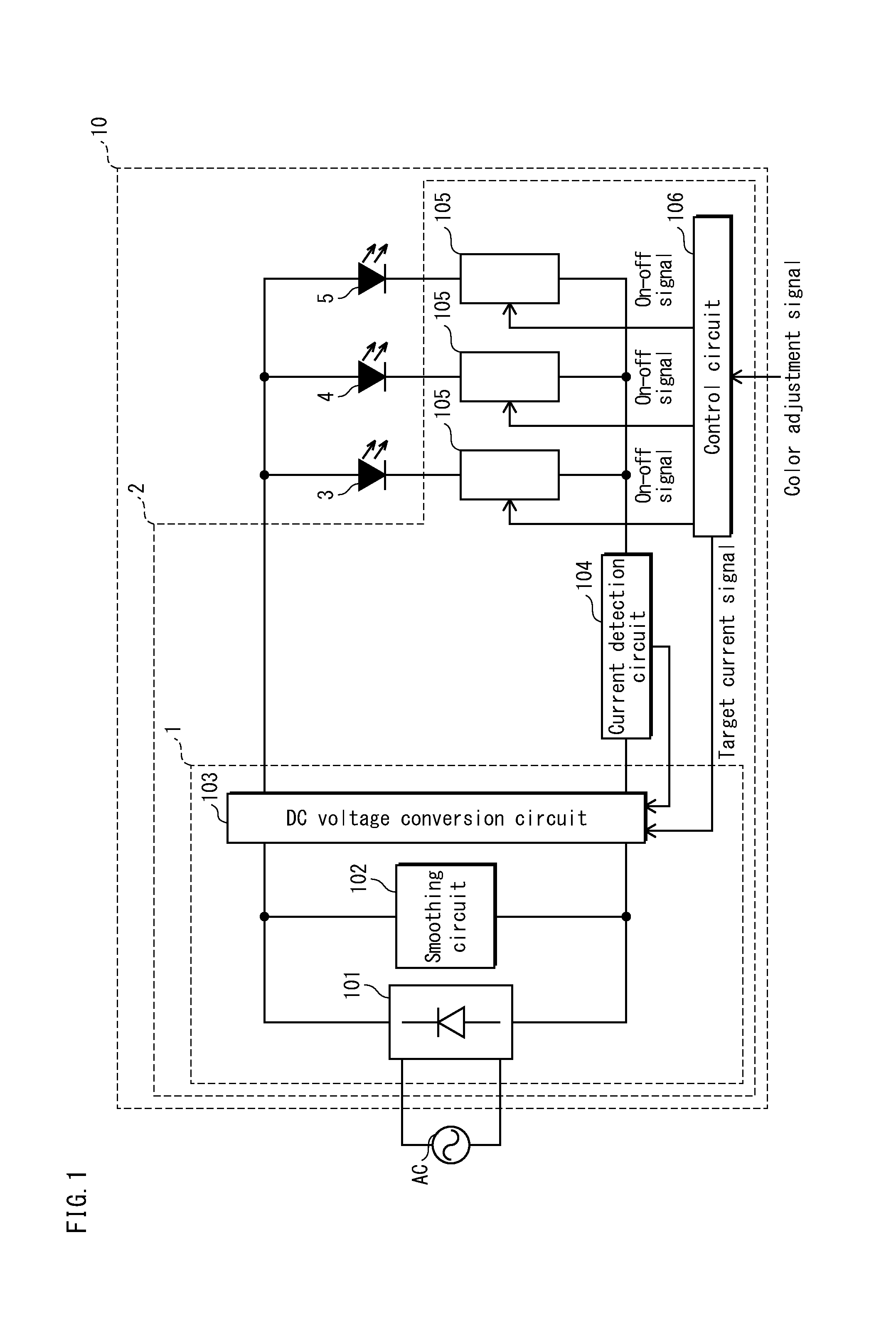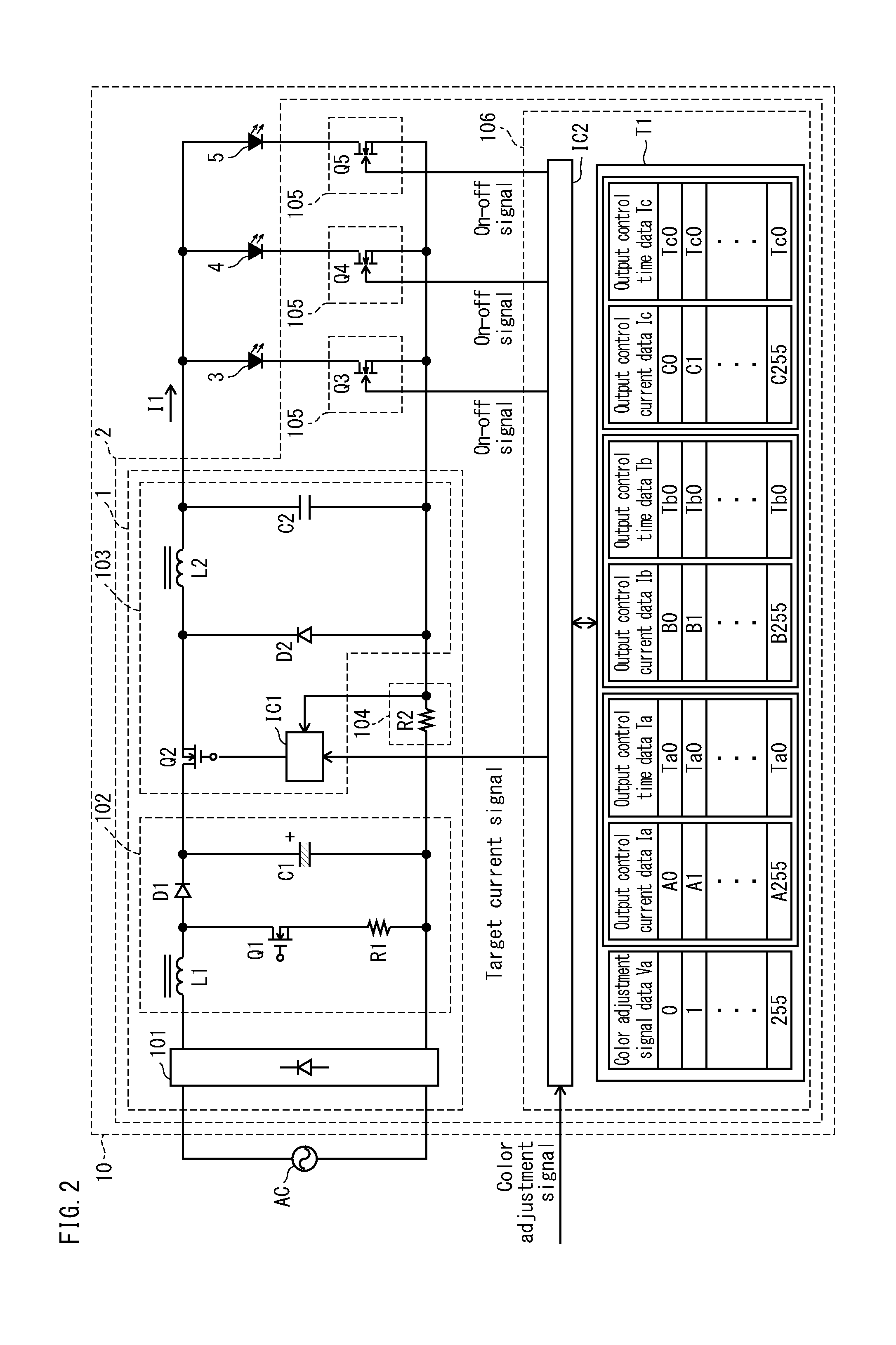Illumination apparatus and lighting device used thereby
a technology of illumination apparatus and lighting device, which is applied in the direction of lighting apparatus, electrical apparatus, light sources, etc., can solve the problems of disadvantageous consumption of electric power, and achieve the effect of reducing power consumption and power consumption
- Summary
- Abstract
- Description
- Claims
- Application Information
AI Technical Summary
Benefits of technology
Problems solved by technology
Method used
Image
Examples
first embodiment
[0041]The following explains, with reference to FIGS. 1-4, an illumination apparatus relating to a first embodiment of the present invention. Note that the first embodiment is explained for an example in which LEDs are used as light sources.
[0042]1. Circuit Configuration
[0043]As illustrated by the block diagram in FIG. 1, an illumination apparatus 10 includes a lighting device 2 and LEDs 3, 4, and 5. The LEDs 3, 4, and 5 differ from one another in terms of light-emission color. In the present embodiment, light-emission colors of the LEDs 3, 4, and 5 are for example red (R), green (G), and blue (B) respectively. The lighting device 2 lights the LEDs 3, 4, and 5 in order, one at a time, at a high speed such that a person is unable to perceive flashing on and off of the LEDs 3, 4, and 5. The above configuration makes it possible to obtain mixed light by mixing light-emission colors of the LEDs 3, 4, and 5. When lighting the LEDs 3, 4, and 5 one by one, the lighting device 2 adjusts a r...
second embodiment
[0073]The following explains a second embodiment of the present invention with reference to the circuit diagram in FIG. 5 and the waveform diagram in FIG. 6. The second embodiment differs from the first embodiment in terms that when target chromaticity indicated by a color adjustment signal varies, a ratio of switches in terms of on-period length is changed for every color adjustment signal data, while output current from a DC voltage conversion circuit remains fixed at a constant value. The following explanation focuses on differences between the first embodiment and the second embodiment. Elements of configuration which are the same as in the first embodiment are labeled using the same reference signs and explanation thereof is omitted.
[0074]As illustrated by the circuit diagram in FIG. 5, an illumination apparatus 210 includes a lighting device 202. The lighting device 202 includes a control circuit 206. The control circuit 206 includes a micro-computer IC2 and a chromaticity tab...
third embodiment
[0077]Color of mixed light is adjusted in the first embodiment through adjustment of a ratio of magnitudes of output current from the DC voltage conversion circuit, and is adjusted in the second embodiment through adjustment of a ratio of on-period lengths of the switching elements. In contrast to the first and second embodiments, in a third embodiment of the present invention, color of mixed light is adjusted through adjustment of both a ratio of magnitudes of output current from a DC voltage conversion circuit and a ratio of on-period lengths of switching elements.
[0078]The following explains the third embodiment with reference to the circuit diagram in FIG. 7 and the waveform diagram in FIG. 8. The third embodiment differs from the first embodiment in terms that a ratio of magnitudes of output current from a DC voltage conversion circuit is adjusted while also adjusting a ratio of on-period lengths of switches. The following explanation focuses on differences between the first em...
PUM
 Login to View More
Login to View More Abstract
Description
Claims
Application Information
 Login to View More
Login to View More - R&D
- Intellectual Property
- Life Sciences
- Materials
- Tech Scout
- Unparalleled Data Quality
- Higher Quality Content
- 60% Fewer Hallucinations
Browse by: Latest US Patents, China's latest patents, Technical Efficacy Thesaurus, Application Domain, Technology Topic, Popular Technical Reports.
© 2025 PatSnap. All rights reserved.Legal|Privacy policy|Modern Slavery Act Transparency Statement|Sitemap|About US| Contact US: help@patsnap.com



